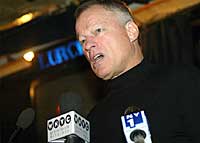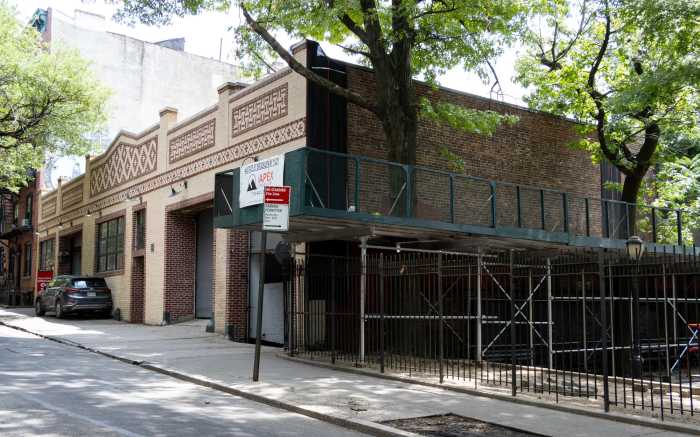As temperatures dipped well below freezing, former Yankee all-star pitcher
Jim Bouton took to the streets of Prospect Heights Wednesday morning with
reporters and local residents in tow.
While Bouton now lives in Massachusetts and hasn’t pitched for the
Bronx Bombers in close to 40 years, the man who exposed the seamy underside
of baseball in his 1970 book “Ball Four” came to Brooklyn this
week to rally against a professional basketball arena proposed for construction
at Atlantic and Flatbush avenues.
The tour capped a two-day whirlwind of speaking engagements, book signings,
and rallies for Bouton, who recently published his second book, “Foul
Ball,” an in-depth diary of his fight to save Wahconah Park in Pittsfield,
Mass., one of the oldest baseball fields in the country. A group of developers
wanted to tear it down and build a new one a couple of miles away.
Bouton says the fight in Prospect Heights is no different.
“You’re not alone, this is an issue nationwide,” Bouton
told about 100 anti-arena activists gathered in the backroom of Freddy’s,
a Prohibition-era bar on Sixth Avenue at Dean Street that would be taken
by eminent domain to build the stadium.
Noting the similarities between his fight and theirs, he said that developers
often use the same “fuzzy financing” and “secret meeting”
tactics to make both stadium and arena deals.
Just last month, developer Bruce Ratner announced plans to buy the New
Jersey Nets and bring them to Brooklyn by building what he is calling
“Atlantic Yards,” a $2.5 billion housing and office complex
centered around a 20,000-seat basketball arena. Renowned architect Frank
Gehry has drawn up the designs.
The project would stretch from Flatbush to Vanderbilt avenues between
Atlantic Avenue and Dean Street and would be built over the Long Island
Rail Road yards.
Gov. George Pataki, Mayor Michael Bloomberg and Borough President Marty
Markowitz are rallying behind the proposal as a growing group of opponents,
many of whom are in danger of losing their homes, are fighting it.
The Prospect Heights Action Coalition, which has been leading that fight,
invited Bouton down from his home in Egermont, Mass., to visit the site
and talk about his own experiences fighting a sports complex plan.
At Freddy’s, Bouton encouraged the opponents to fight the good fight.
Patti Hagan, a founding member of the coalition, announced the results
of a community survey that she said found that more than 1,000 residents
and workers in 71 buildings would be booted from their homes when the
wrecking ball came.
“This is not ugly,” Bouton exclaimed as he admired the industrial
and residential buildings that would be razed to make way for the 17 towers
reaching as tall as 60 stories.
In order to build there Ratner would have to first obtain development
rights over the Long Island Rail Road yards and get the state to take
over two square blocks of privately owned property by eminent domain,
a power of the government to seize private land for the public good.
The project, most of which is on MTA-owned land, would go through state
review, bypassing the more rigorous city land use review process.
Spokespeople for both Ratner and the mayor have said the community will
have input into the plan, but it is not clear what role, if any, the community
will play.
The financing for the project is still not entirely clear.
Ratner, who is seeking Liberty Bonds to complete his New York Times building
in Manhattan, has said he plans to use taxes generated from the arena
— everything from concession sales to players’ multi-million
salaries — to complete the surrounding office and residential buildings.
Bouton railed against the tax abatement calling it “corporate welfare.”
And he warned that if it gets built, the arena will one day also face
obsolescence. “If this stadium gets built, 20 years from now you’ll
hear, ‘These Frank Gehry stadiums are out of date.’ So we’re
going to be leaving Brooklyn for another place with a Libeskind stadium,”
Bouton said, referring to World Trade Center site architect Daniel Libeskind.
After retiring from baseball, Bouton worked for years as a sportscaster
at WABC and WCBS, and did not go unrecognized during his Prospect Heights
tour.
“Hey, I know that guy,” shouted a Long Island Rail Road employee
as Bouton passed by.
Dennis Petersen, an avid sports fan, has been working for the LIRR for
the past six years.
“Why should people have to lose their homes?” asked Petersen.
“Just five blocks away the area is in total decay,” he said.
“They could build over there.”

























